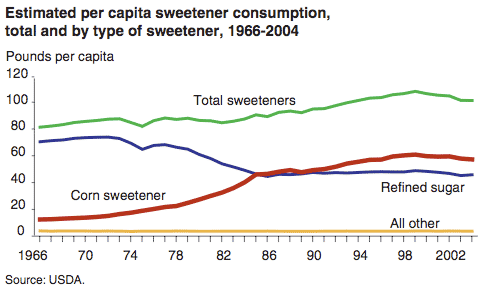Put that fruit juice down and grab a Coke.
Haven’t you heard? High-fructose corn syrup — the ubiquitous sweetener found in everything from soft drinks to ketchup — isn’t bad for you at all. It’s true, because I saw it on TV.
Back in June, the Corn Refiners Association embarked on what the Wall Street Journal described as an 18-month, $20-30 million campaign to “rehabilitate the reputation of the longtime sweetener.” The blitz includes full-page ads in more than a dozen newspapers and prime-time television spots.
The industry is evidently worried about losing its grip over a key consumer demographic: kids. To stave off that unhappy fate, the corn refiners are currying favor with those who monitor kids’ food choices. “The lion’s share of the ads will run on media that specifically target moms,” the Journal reported.
It’s easy to see why the industry is fretting. As the accompanying chart shows, corn sweetener consumption peaked in 1998 and has been dropping since, pressured by growing concern over diabetes and obesity. Yet high-fructose corn syrup remains the dominant U.S. sweetener — Americans consume about 50 pounds of it per capita every year, versus a little more than 40 pounds of refined sugar.
And corn-processing powerhouse Archer Daniels Midland — which owns about a third of the domestic HFCS market– still makes considerable money from it. In the year ended June 30, 2008, sweeteners delivered $529 million to ADM’s bottom line. That’s more than its much-ballyhooed ethanol division brought in ($432 million) and about a sixth of the company’s overall operating profit.
So that’s what’s at stake for the industry: a sweet source of steady profit. But what about consumers? Are they really in for what the industry’s marketing campaign calls a “sweet surprise” — that they can go on blithely consuming (and feeding their kids) high-fructose corn syrup without health consequences?
Bitter Ironies
First of all, the ads’ claim that HFCS is “fine in moderation” glosses a hard truth for an industry that thrives on immoderation. The golden age of HFCS — roughly 1978 to 1998 — was an era of mindless bingeing on sweetened foods. This was the time of the Big Gulp and of liquid substances that “contain fruit juice” but owed most of the their flavor to a sweet blast of HFCS.

As the chart shows, corn sweetener consumption jumped from 20 pounds per capita per year in 1978 to more than 60 in 1998. That 200 percent jump more than offset a decline is refined sugar use. Overall, sweetener use rose steadily over the period. By the end, HFCS was showing up not just in soft drinks but also in stuff like hamburger buns. In other words, the U.S. sweet tooth suddenly began ramping up in the late 1970s, and the corn industry was there to satisfy it.
Why did HFCS consumption take off in the early 1980s? The catalyst did not come from any change in consumer preference or quirk of the free market. Rather, corn sweetener owes its ubiquity to changes in government policy — ones pushed through by the industry itself, especially its biggest player, Archer Daniels Midland.
As Richard Manning shows in his Against the Grain, HFCS failed to gain a foothold in the soft drink in the 1970s — and without conquering Coca Cola, Pepsi, et al, HFCS was doomed to be a marginal player in the sweetener business. In short, despite its best efforts, Archer Daniels Midland couldn’t engineer a corn sweetener that was cheaper than sugar.
Stymied in the lab, the corn-processing giant searched for solutions in the political arena. ADM was arguably the most politically powerful corporation of the 1970s. Then-CEO Dwayne Andreas gained legendary status as a double-dealer during the Watergate investigations, when the congressional hearings revealed that he had cut the $25,000 check used by Richard Nixon’s “plumbers” to finance the infamous hotel break-in. From the same hearings it emerged that Andreas had illegally donated $100,000 to Minnesota Sen. Hubert Humphrey in 1968 — Nixon’s Democratic opponent in that year’s election and a longtime Andreas favorite.
According to Manning, ADM began in the late 1970s to finance a lobbying effort to strictly limit the amount of foreign sugar that could be imported into the United States. In 1982, another Andreas friend, President Ronald Reagan, signed into law draconian sugar quotas that remain in effect to this day. (The free-market champion must have felt sheepish signing this blatantly interventionist act.) The domestic price of sugar immediately spiked, and food manufacturers — including, crucially, soft-drink bottlers — quickly began substituting HFCS for sugar.
And as corn prices generally dropped through the 1980s and into the ’90s — pushed down in part by U.S. farm policies also promoted by ADM — the industry began to churn out more and more HFCS, and its price came down. That’s why manufacturers began putting it seemingly in everything — and U.S. sweetener consumption boomed along with obesity and diabetes rates.
Fat of the Land
Insofar as the rise of the HFCS industry gave the U.S. diet a jolt of empty calories, it almost surely contributed to surging obesity and diabetes rates.
The question remains about whether, as some researchers suggest, HFCS triggers more weight gain than equivalent amounts of refined sugar. Both are fragmented substances, stripped of trace nutrients to deliver pure sweetness. In HFCS production, complex carbohydrates are broken down industrially with enzymes — some of them genetically modified — to produce a combination of fructose and glucose.
According to the industry, the body metabolizes HFCS and refined sugar just the same. On its website, the Corn Refiners Association points to six academic studies [PDF] showing no difference in metabolism. But as CBS News recently reported, “Three were sponsored by groups that stand to profit from research that promotes HFCS. Two were never published so their funding sources are unclear. And one was sponsored by a Dutch foundation that represents the interests of the sugar industry.”
Industry cash doesn’t nullify academic work, but it surely influences what questions get asked. And other research contradicts the studies trotted out by the Corn Refiners Association. For example, in a paper published in the American Journal of Physiology — Regulatory, Integrative and Comparative Physiology (funded by the National Institutes of Health), University of Florida researchers found that fructose-heavy diets “can induce leptin resistance, a condition that can easily lead to becoming overweight.” Leptin is a substance produced by the body to trigger feelings of satiety; it tells us when to stop eating.
Clearly, more independent research needs to be done about high-fructose corn syrup’s effects. More clearly still, we continue gobbling up too much refined sweetener. Sweetener consumption has dropped in recent years but remains at levels well above those that held sway before the advent of HFCS. Instead of casually pouring her kids a highly sweetened beverage, the mother in the Corn Refiners ad should dump it down the drain.


